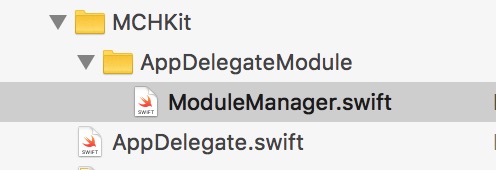现在很多的大型项目基本都是多人协作的,基本都是以组件化开发为主,减少不同开发人员之间的相互影响,小中型项目有没有必须使用呢,有人说没必要,杀鸡焉用牛刀,其实是有必须要的,虽然代码量有增加,但是最起码代码结构更清晰,也利于代码维护,如果去做大型项目也能提早适应,再者也是对编码能力的提升,好处很多啊。
下面从swift开发iOS为例来做个介绍。
AppDelegate是iOS开发中一个很重要的类,很多系统的事件处理都在这个类下,如推送,分享,支付等等,这个类加太多的处理会导致很臃肿,有人建议说可以用分类,这也是一种办法,
分类有一个不好的地方就是会导致代码分散,阅读性会差一些。从设计模式的6大原则来解决问题,可以有其它的解决方案。AppDelegate下相关的代理还是写在其下,AppDelegate只做粘合作用,其它不同的业务需要单独处理,定义到自己的业务类中。
项目中的MCHKit文件夹只做共用代码包,与业务无关,拿到任何项目中都可以拿来直接使用,并不会报错。下面以推送功能为例.
在项目的MCHKit下创建 ModuleManager类,包含一个ModuleManagerDelegate 协议,业务类需要实现ModuleManagerDelegate协议,作为业务组件和AppDlegate通信的桥梁。
所有组件的基类

具体实现,定义一个ModuleManager.swift
// SwfitDemo
// Created by menchao on 2018/9/26.
// Copyright © 2018年 cedarhd. All rights reserved.
import UIKit
@objc public protocol ModuleManagerDelegate {
@objc optional func application(_ application: UIApplication, didFinishLaunchingWithOptions launchOptions:[UIApplicationLaunchOptionsKey : Any]?)
//其它的处理。。。
func applicationWillResignActive(_ application: UIApplication)
func applicationDidEnterBackground(_ application: UIApplication)
}
public class ModuleManager : NSObject{
static let sharedInstace = ModuleManager.init()
private override init(){
}
public func loadModule(_ module: ModuleManagerDelegate? ){
if((module) != nil){
self.allModules.append(module!)
}
}
public func loadAllModule(_ modules:[Array<ModuleManagerDelegate>]?){
if((modules) != nil){
self.allModules.removeAll()
for item in modules!{
self.allModules.append(item as! ModuleManagerDelegate)
}
}
}
// MARK: - app delegate
public func application(_ application: UIApplication, didFinishLaunchingWithOptions launchOptions:[UIApplicationLaunchOptionsKey : Any]?){
for service in self.allModules {
let serviceDelegate = service
if serviceDelegate.application != nil{
serviceDelegate.application!(application, didFinishLaunchingWithOptions: launchOptions)
}
}
}
lazy var allModules: Array<ModuleManagerDelegate> = {
var array = Array<ModuleManagerDelegate>()
return array
}()
}
ModuleManagerDelegate里的名称可以改为自己的名称,为了和系统相呼应,建议和系统保持一样的名字。
定义一个推送消息模块RemotePushMoudel,继承ModuleManagerDelegate,用来处理协议方法。如下,把推送相关的处理用extension定义,减少AppDelegate的臃肿import UIKit
import UserNotifications
// MARK: - push extension
extension AppDelegate{
func application(_ application: UIApplication, didRegisterForRemoteNotificationsWithDeviceToken deviceToken: Data) {
print("deviceToken: \(deviceToken)")
}
func application(_ application: UIApplication, didFailToRegisterForRemoteNotificationsWithError error: Error){
}
func application(_ application: UIApplication, didReceiveRemoteNotification userInfo: [AnyHashable : Any]){
//方法1.此处处理推送业务逻辑 具体的业务实现
//do something
//方法2. 为了减少耦合,也可以把业务逻辑单独定义实现
PushBusiness.oneBusinessReceiveRemotePush(userInfo: userInfo)
}
func application(_ application: UIApplication, didReceiveRemoteNotification userInfo: [AnyHashable : Any], fetchCompletionHandler completionHandler: @escaping (UIBackgroundFetchResult) -> Void) {
}
}
class RemotePushMoudel:NSObject, ModuleManagerDelegate, UNUserNotificationCenterDelegate {
var delegate: AppDelegate = UIApplication.shared.delegate as! AppDelegate
func application(_ application: UIApplication, didFinishLaunchingWithOptions launchOptions: [UIApplicationLaunchOptionsKey : Any]?){
print("TestRemotePush 实现 application")
self.registerAppNotificationSettings(launchOptions: launchOptions)
}
func registerAppNotificationSettings(launchOptions: [UIApplicationLaunchOptionsKey : Any]?) {
if #available(iOS 10.0, *) {
let notifiCenter = UNUserNotificationCenter.current()
notifiCenter.delegate = self
let types = UNAuthorizationOptions(arrayLiteral: [.alert, .badge, .sound])
notifiCenter.requestAuthorization(options: types) { (flag, error) in
if flag {
print("iOS request notification success")
}else{
print(" iOS 10 request notification fail")
}
}
} else {
let setting = UIUserNotificationSettings(types: [.alert, .badge, .sound], categories: nil)
UIApplication.shared.registerUserNotificationSettings(setting)
}
UIApplication.shared.registerForRemoteNotifications()
}
// MARK: - RemoteNotification
@available(iOS 10.0, *)
func userNotificationCenter(_ center: UNUserNotificationCenter, willPresent notification: UNNotification, withCompletionHandler completionHandler: @escaping (UNNotificationPresentationOptions) -> Swift.Void){
}
@available(iOS 10.0, *)
public func userNotificationCenter(_ center: UNUserNotificationCenter, didReceive response: UNNotificationResponse, withCompletionHandler completionHandler: @escaping () -> Swift.Void){
}
}
定义一个业务类PushBusiness,这个类可以专门处理推送相关的业务逻辑,实现如下:
//业务处理
class PushBusiness: NSObject {
class func oneBusinessReceiveRemotePush(userInfo: [AnyHashable : Any]) {
print("userInfo: \(userInfo)")
//处理具体推送业务
}
}
定义完了以上,下一步用一个类管理所有的业务,定义 ServiceComponentManager 如下:
import UIKit
public class ServiceComponentManager {
public class func registerAllService(_ application: UIApplication, didFinishLaunchingWithOptions launchOptions:[UIApplicationLaunchOptionsKey : Any]?){ /// add all Moudel //push let pushModule = RemotePushMoudel() ModuleManager.sharedInstace.loadModule(pushModule) //添加其它 //pay //other ModuleManager.sharedInstace.application(application,didFinishLaunchingWithOptions: launchOptions) } }
以上定义好了后,直接在AppDelegate的入口方法添加即可。
class AppDelegate: UIResponder, UIApplicationDelegate {
var window: UIWindow?
func application(_ application: UIApplication, didFinishLaunchingWithOptions launchOptions: [UIApplicationLaunchOptionsKey: Any]?) -> Bool {
// Override point for customization after application launch.
self.window = UIWindow(frame: UIScreen.main.bounds)
self.window?.backgroundColor = UIColor.white
self.window?.rootViewController = RootTabBarController()
self.window?.makeKeyAndVisible()
//注册服务模块
ServiceComponentManager.registerAllService(application, didFinishLaunchingWithOptions: launchOptions)
return true
}
}
通过以上说明,可以做到对AppDelegate组件化分解,减少AppDelegate的臃肿,这样定义耦合性就很低了,不同的业务互不干扰,方便维护。如果项目需要增加如分享,支付等,都可以使用类似方法,如果想在不同的项目中复用RemotePushMoudel,还可以在改造,RemotePushMoudel放到MCHKit中,业务代码抽离到业务模块类,可以通过通知或delegate等来实现。 虽然代码量稍有增加,但是可读性更强,同时也做到了高内聚,低耦合。